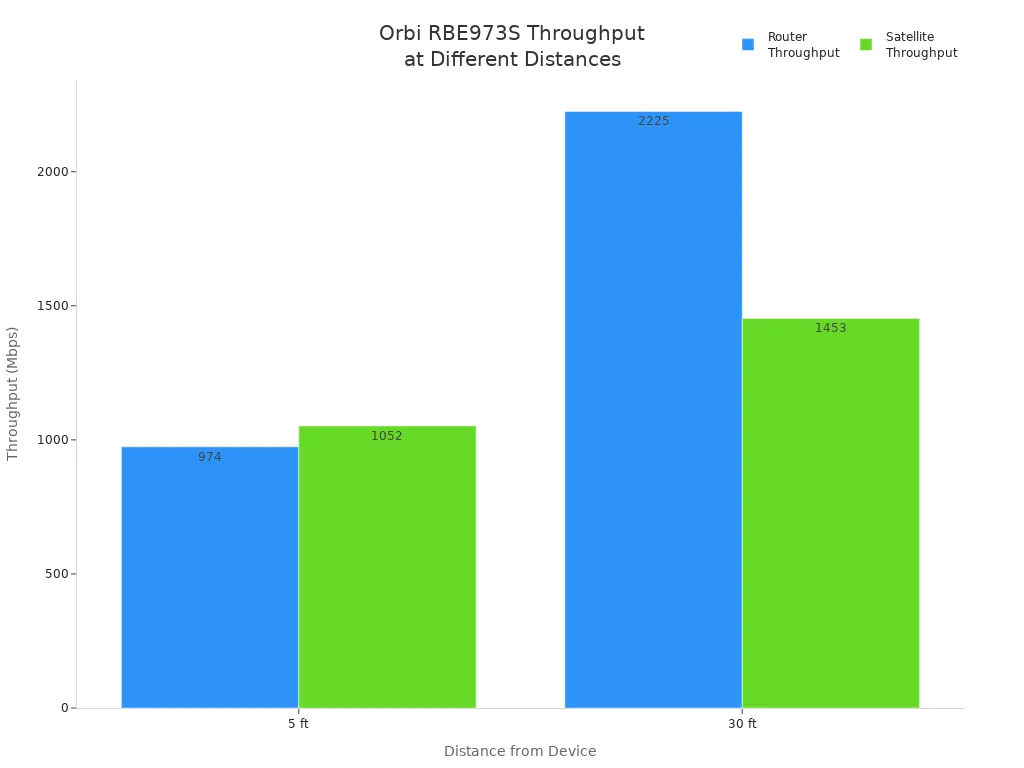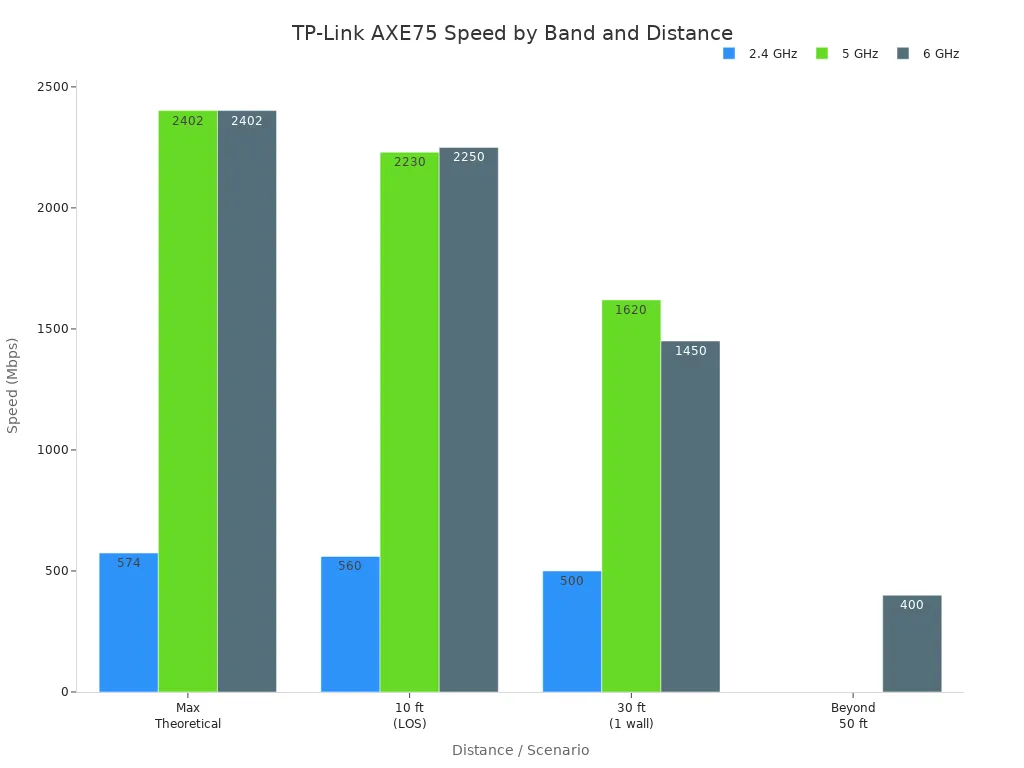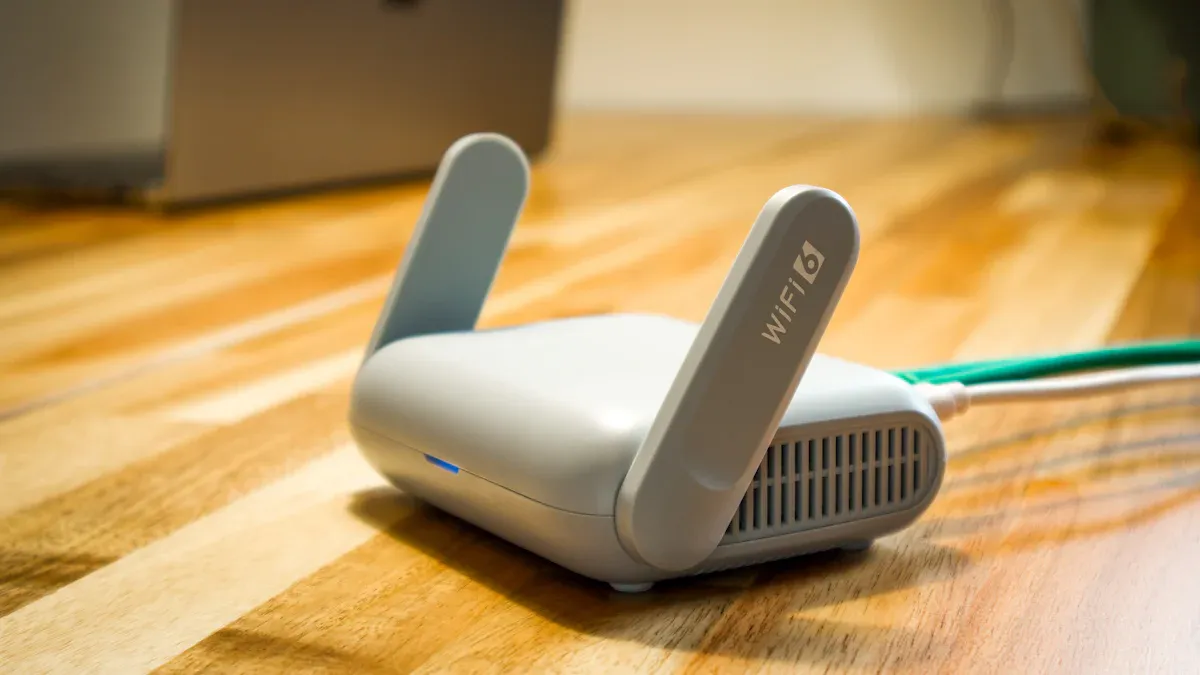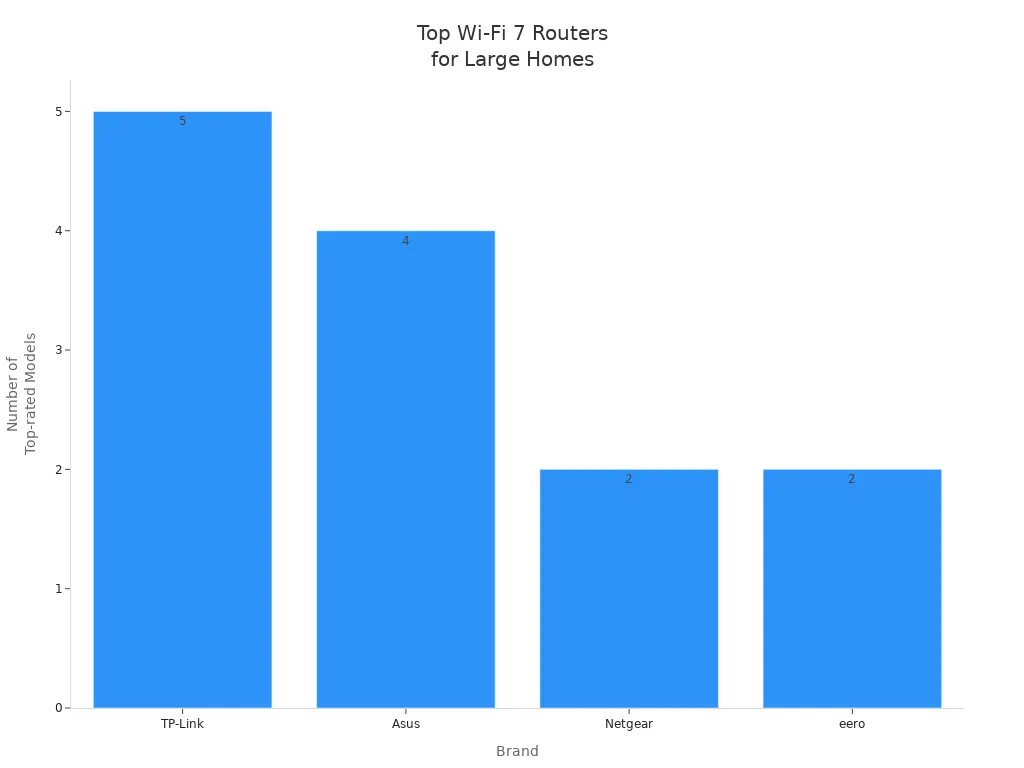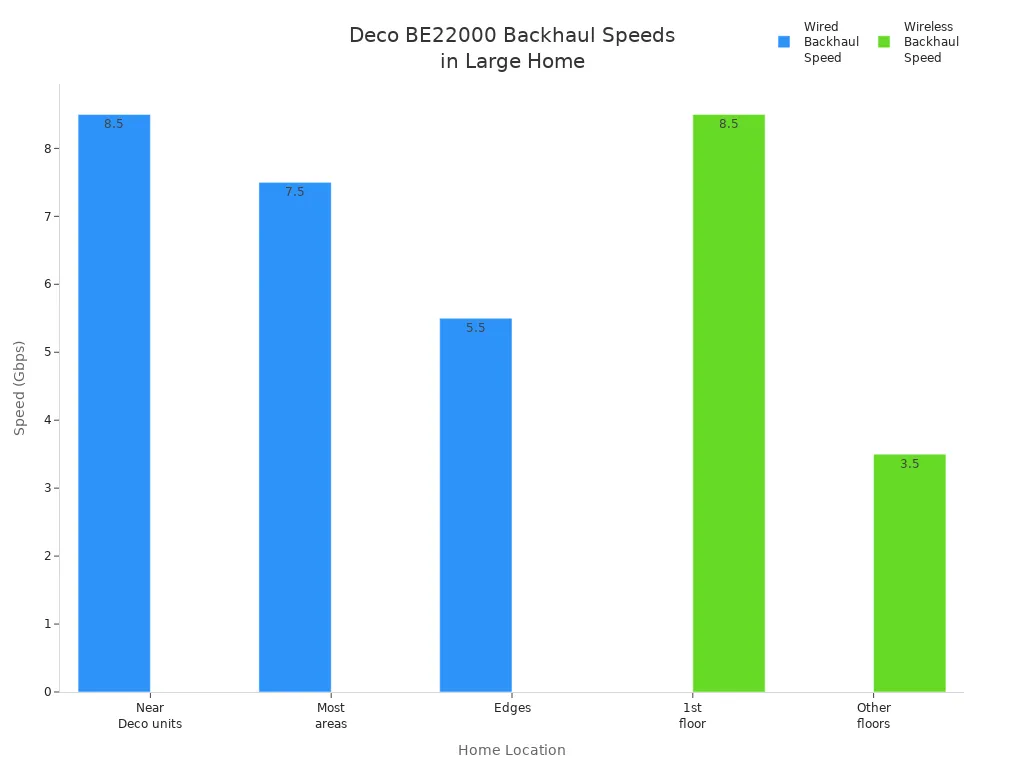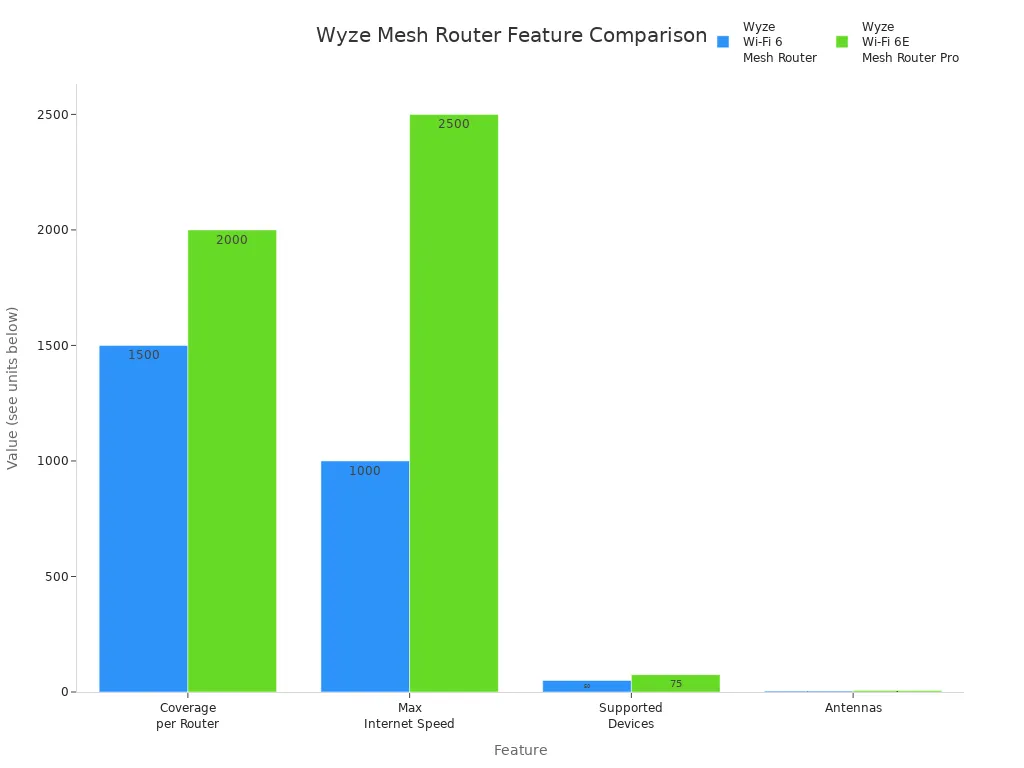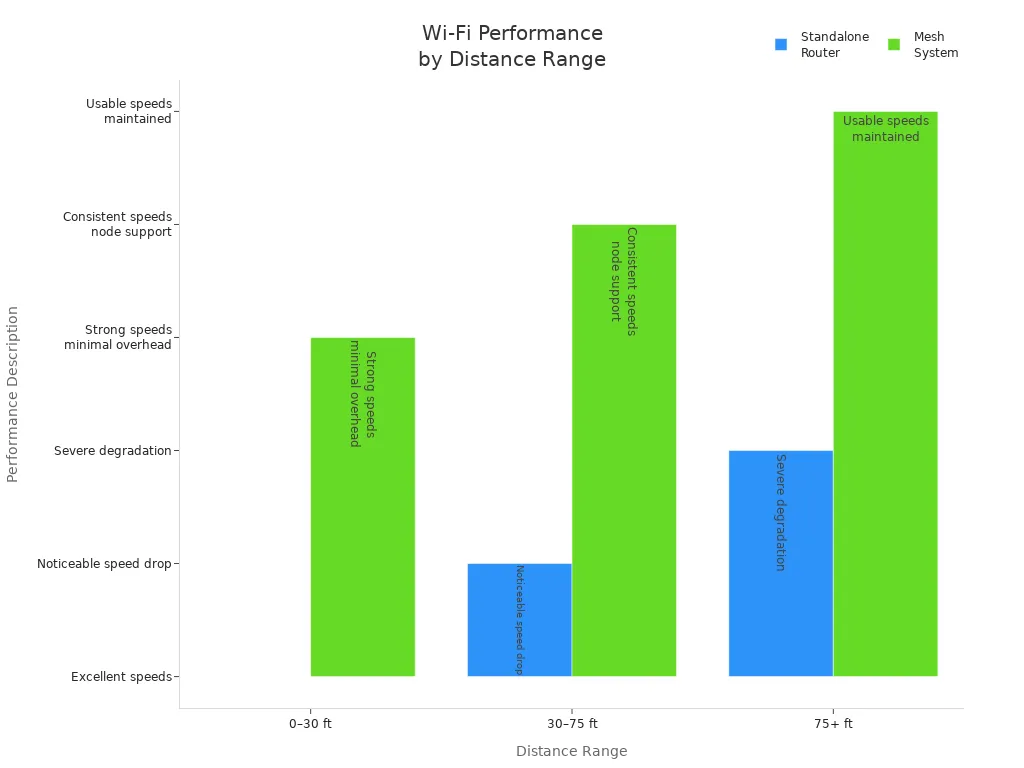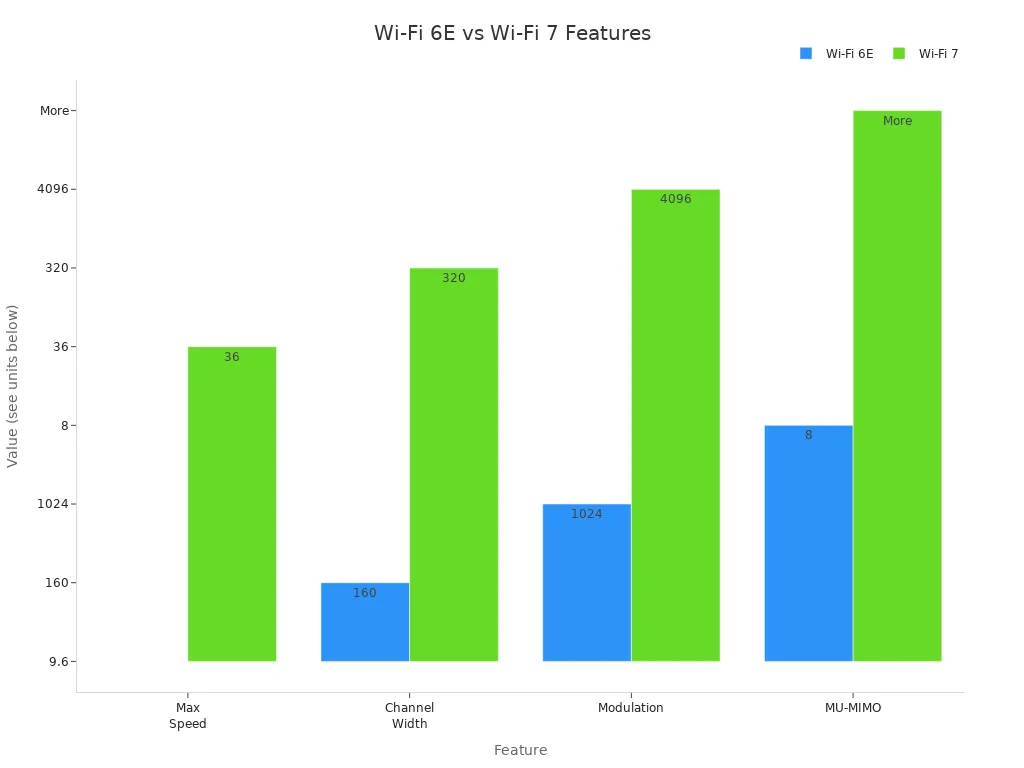If you’re searching for the best wifi router for large home use in 2025, check out this top list: LB-LINK UltraMesh AX3000, Asus ROG Rapture GT-AX6000, Netgear Orbi RBE973S, TP-Link Deco X55 Pro, AmpliFi Alien by Ubiquiti, TP-Link Archer AXE75, and Asus ZenWiFi AX (XT8). Each of these options is considered among the best wifi router for large home setups, helping you avoid weak signals, slow internet, and dropped connections—issues that are common in spacious houses. Every router on this list delivers strong coverage, fast internet speeds, and mesh support, ensuring your entire home stays connected, even with multiple devices in use.
Key Takeaways
Mesh Wi-Fi systems work best for big homes. They help give strong coverage in every room. This stops dead zones from happening.
Wi-Fi 6 and Wi-Fi 7 routers are much faster. They can handle more devices at once. They work better for homes with lots of smart gadgets.
Tri-band and quad-band routers help cut down on crowding. They give devices their own channels. This makes speed and reliability better.
Pick routers that can support lots of devices. Look for MU-MIMO and OFDMA technology. These keep your network running fast and smooth.
Put your router in the middle of your house. Make sure it is in an open area. This helps the signal reach more places. Walls and metal can block signals.
For gaming, get routers with low latency features. Range boosters and gaming ports help you play without lag.
Simple apps and mesh setups make Wi-Fi easy to install. You can manage your network even if you are not a tech expert.
Think about your home size and how many devices you have. Also, consider your smart home needs. This helps you pick the best router for value and performance.
Best Wi-Fi Router for Large Home
Choosing the best wifi router for large home use can feel overwhelming. You want strong wi-fi signals in every room, fast speeds for streaming, and support for all your devices. This list covers the top routers that deliver whole-home mesh coverage, high-speed internet, and reliable connections. Let’s look at the best options for 2025.
LB-LINK UltraMesh AX3000
If you want one of the best wi-fi routers for large homes, the LB-LINK UltraMesh AX3000 should be on your list. This router stands out for its blend of speed, coverage, and security. You get Wi-Fi 6 technology, which means faster wireless speeds and better performance when lots of devices connect at once. The mesh support lets you add more units, so you can cover every corner of your home—even on multiple floors.
Key Features
Wi-Fi 6 (802.11ax) delivers wireless speeds up to 3000Mbps. You can stream, game, and work without lag.
Easy Mesh support gives you seamless whole-home mesh coverage. You can walk from room to room without losing your connection.
OFDMA and MU-MIMO help your router handle many devices at once. You get less lag and smoother performance.
Full gigabit Ethernet ports let you plug in for high-speed wired connections.
WPA3 security keeps your network safe from hackers.
You’ll find this router easy to set up. The app guides you through each step. If you have a large home with lots of smart devices, this router makes sure everyone stays connected.
Asus ROG Rapture GT-AX6000
Looking for the best overall wi-fi router for gaming and streaming? The Asus ROG Rapture GT-AX6000 is a top choice. This router shines in multi-story homes. You get strong wi-fi coverage, even in spots where other routers struggle. Users say it covers large two-story homes, up to 3,800 square feet, with no dead zones.
The GT-AX6000 uses Range Booster Plus and high-gain antennas. You get strong signals through walls and floors. At 70 feet, speeds stay fast enough for streaming and gaming. You can connect many devices at once without drops. Compared to other routers, this model gives you up to 38% more coverage. If you want the best wi-fi router for large home gaming, this one should be on your list.
Wi-Fi 6 dual-band for fast speeds
Range Booster Plus for better wall penetration
Handles many devices at once
Great for gaming and streaming
Netgear Orbi RBE973S
If you need the best wi-fi routers for huge homes, the Netgear Orbi RBE973S is hard to beat. This router uses Wi-Fi 7 quad-band technology. You get blazing speeds and coverage for up to 10,000 square feet. It supports up to 200 devices, so your whole family can connect phones, laptops, and smart gadgets.
Here’s a quick look at what you get:
Specification | Details |
Coverage | Up to 10,000 sq. ft. |
Maximum Speed | Up to 27 Gbps |
Supported Devices | Up to 200 devices |
Wi-Fi Technology | Wi-Fi 7 Quad-Band |
Satellite Coverage | Up to 3,300 sq. ft. |
Ethernet Ports | One 10Gbps WAN, One 10Gbps LAN, Four Multi-Gig LAN |
Antennas | 12 high-performance internal antennas |
You get dedicated backhaul, so your wi-fi stays fast everywhere. Even at 30 feet, the router delivers speeds over 2,200 Mbps. The satellite units also keep speeds high, so you can work or play in any room.
Metric | Value |
Maximum Coverage | Up to 10,000 sq. ft. |
Supported Devices | Up to 200 devices |
Router Throughput (5GHz band) at 5 feet | 974 Mbps |
Satellite Throughput (5GHz band) at 5 feet | 1,052 Mbps |
Router Throughput (5GHz band) at 30 feet | 2,225 Mbps |
Satellite Throughput (5GHz band) at 30 feet | 1,453 Mbps |
If you want the best wifi router for large home setups, the Orbi RBE973S should be on your list. You get top speeds, wide coverage, and support for all your devices.
TP-Link Deco X55 Pro
If you want a wi-fi router that can handle a big house, the TP-Link Deco X55 Pro is a smart pick. This system comes as a three-pack, so you get coverage for up to 6,500 square feet. That means you can walk from your basement to your attic without losing your wi-fi signal. The Deco X55 Pro uses AI-driven mesh technology, which keeps your connection strong and smooth, even if you have a lot of rooms or thick walls.
You probably have a lot of gadgets at home. This router supports over 150 devices at once. You can stream movies, play games, and run smart home devices without worrying about slowdowns. The wi-fi speeds reach up to 3.0 Gbps, so you get fast internet for everything you do.
Here’s why the Deco X55 Pro stands out for large homes:
Covers up to 6,500 square feet with a three-pack system. You can add more units if you need even more coverage.
Handles over 150 connected devices, perfect for smart homes.
Wi-fi 6 technology gives you fast and efficient wireless performance.
Two 2.5 Gbps WAN/LAN ports let you plug in for ultra-fast wired connections.
AI-driven mesh keeps your wi-fi seamless as you move around.
Real-time cybersecurity protection helps keep your network safe.
The Deco app makes setup and management easy, with parental controls and device alerts.
Tip: The Deco X55 Pro blends in with your home décor and keeps your wi-fi strong, even in your backyard or garage.
AmpliFi Alien by Ubiquiti
The AmpliFi Alien by Ubiquiti is a powerful wi-fi router built for big families and tech lovers. If you have a lot of people using the internet at the same time, this router keeps everyone happy. It uses 12 polarity antennas and supports 4x4 on 2.4 GHz, 4x4 on 5 GHz (low band), and 8x8 on 5 GHz (high band). That means it can talk to many devices at once without slowing down.
You get wi-fi 6 technology, which uses MU-MIMO and OFDMA. These features help your router send data to lots of devices at the same time. The AmpliFi Alien can handle 4K and 8K streaming, gaming, and video calls all at once. You won’t see lag, even if everyone is online.
Mesh networking extends coverage and kills dead spots in your home.
The router has a fast Quad-Core Cortex A53 chip and 1 GB RAM, so it runs smoothly.
Five Ethernet ports let you plug in devices that need a steady connection.
The AmpliFi app gives you easy controls and shows you what’s happening on your network.
This router is made for homes with lots of wi-fi devices, so you never have to worry about slow speeds.
Note: The AmpliFi Alien is great if you want a wi-fi router that can handle a busy, connected home with no fuss.
TP-Link Archer AXE75
The TP-Link Archer AXE75 is a tri-band wi-fi 6E router that brings fast speeds and wide coverage to your home. If you live in a house up to 2,500 square feet, this router gives you strong wi-fi in every room. It uses six high-gain antennas and Beamforming technology to push the signal through walls and floors.
You get three bands: 2.4 GHz, 5 GHz, and 6 GHz. The 6 GHz band is super fast but works best when you’re close to the router. The 5 GHz band gives you stable speeds even when you’re farther away. Real-world tests show gigabit-class wi-fi speeds at close range, and the router keeps a strong signal even at 40 feet.
Frequency Band | Maximum Speed | Speed at 10 ft | Speed at 30 ft | Speed beyond 50 ft |
2.4 GHz | 574 Mbps | ~560 Mbps | ~500 Mbps | Stable connection |
5 GHz | 2402 Mbps | ~2230 Mbps | ~1620 Mbps | Drops ~30% after one wall |
6 GHz | 2402 Mbps | ~2250 Mbps | ~1450 Mbps | ~400 Mbps, shorter range |
This router supports over 200 devices at once, thanks to OFDMA and MU-MIMO. You can add TP-Link OneMesh extenders if you want to boost your wi-fi to every corner. The 1.7 GHz Quad-Core CPU keeps everything running smoothly, even when your whole family is online.
Tri-band wi-fi 6E with speeds up to 5400 Mbps.
Six antennas and Beamforming for strong, wide coverage.
Handles 200+ devices, perfect for busy homes.
OneMesh compatibility for easy range extension.
Enhanced heat dissipation keeps your router cool during heavy use.
If you want a reliable wi-fi router that delivers fast speeds and supports lots of devices, the Archer AXE75 is a solid choice for large homes.
Asus ZenWiFi AX (XT8)
If you want a mesh Wi-Fi system that covers every inch of your large home, the Asus ZenWiFi AX (XT8) is a smart pick. This router stands out because it uses tri-band Wi-Fi 6. That means you get fast speeds, even when everyone in your house is online at the same time. You can stream movies, play games, and join video calls without worrying about slowdowns.
The ZenWiFi AX (XT8) comes as a two-pack. You can place one unit on each floor or at opposite ends of your house. This setup helps you get rid of dead zones. You will notice strong Wi-Fi in your basement, upstairs bedrooms, and even out on the patio. The system can cover up to 5,500 square feet, so it works well for big homes.
You get a lot of features with this router. Asus includes AiProtection Pro, which keeps your network safe from online threats. You also get parental controls. These let you manage what your kids can see online and set time limits for their devices. The router supports wired backhaul, so you can connect the two units with an Ethernet cable for even faster speeds.
Here’s what experts say about the Asus ZenWiFi AX (XT8):
Fast tri-band Wi-Fi 6 gives you strong performance, even with many devices connected.
The feature set is robust. You get AiProtection Pro security and advanced parental controls.
The range is great for large homes. You can expect reliable coverage in every room.
Wired magazine and other tech experts rank the XT8 as a top choice for mesh Wi-Fi in big houses.
You should know about a couple of downsides. The setup process can feel a bit more complex than with some other mesh systems. The hardware is also larger than most routers, so you need to find space for it on your shelves or tables.
Tip: If you want the best performance, use the wired backhaul feature. This gives you the fastest speeds between the two units.
The ZenWiFi AX (XT8) works well if you have a lot of smart home devices. It handles streaming, gaming, and video calls all at once. You can add more units if you need even more coverage. The app makes it easy to manage your network, check speeds, and set up guest Wi-Fi.
If you want a reliable, secure, and fast mesh Wi-Fi system for your large home, the Asus ZenWiFi AX (XT8) is a top contender. You get peace of mind, strong signals, and features that help your whole family stay connected.
Best Wi-Fi 7 Routers
If you want the best wi-fi experience in your large home, you should look at the top wi-fi 7 routers. These routers bring the latest technology, giving you faster speeds, better coverage, and support for more devices than ever before. Wi-fi 7 routers are perfect for homes with lots of smart gadgets, streaming, and gaming. Let’s check out the best wi-fi 7 routers for 2025.
Netgear Orbi RBE973S
The Netgear Orbi RBE973S stands out as one of the best wi-fi 7 routers for large homes. This router uses quad-band wi-fi 7 technology, so you get blazing fast wi-fi 7 speeds and strong signals in every room. You can cover up to 10,000 square feet with this system, making it a top choice for big houses or multi-story homes. The Orbi RBE973S supports up to 200 devices at once, so everyone in your family can connect their phones, laptops, and smart home devices without slowdowns.
If you want the best wi-fi 7 router for long range, the Orbi RBE973S is hard to beat. It’s also a great pick if you have fiber internet and want the best wi-fi 7 router for fiber.
Here’s a quick look at how the top wi-fi 7 routers for large homes compare:
Brand | Model Name | Type | Coverage Suitability |
Netgear | Orbi RBE973S | Mesh System | Large homes (>2,000 sq ft) |
TP-Link | Deco BE23 BE3600 (2-Pack) | Mesh System | Large homes (>2,000 sq ft) |
Asus | ZenWiFi BT8 (2-Pack) | Mesh System | Large homes (>2,000 sq ft) |
eero | eero 7 (2-pack) | Mesh System | Large homes (>2,000 sq ft) |
TP-Link Deco BE22000
The TP-Link Deco BE22000 is another top pick among the best wi-fi 7 routers. This mesh system covers up to 4,600 square feet, making it perfect for big homes with lots of rooms. You get tri-band wi-fi 7 speeds up to 22 Gbps, so you can stream, game, and work all at once. The Deco BE22000 supports over 200 devices, so your whole family can stay connected.
You’ll love the AI-driven mesh technology. It keeps your wi-fi strong as you move around your home. Wired backhaul speeds reach up to 9 Gbps near the Deco units, and even at the edges of your house, you still get 5-6 Gbps. Wireless backhaul is also fast, with 3-4 Gbps on other floors. This router uses 8 high-gain antennas and a powerful CPU to keep everything running smoothly.
The Deco BE22000 is one of the best wi-fi 7 routers if you want fast, reliable coverage everywhere.
Ubiquiti UniFi Dream Router 7
The Ubiquiti UniFi Dream Router 7 is a smart choice if you want advanced features and strong security. This router gives you wi-fi 7 speeds up to 5.7 Gbps and supports multi-gigabit connections. You get a 10G SFP+ WAN port and 2.5G LAN ports, so it’s ready for fast internet and local networks.
You’ll find lots of security features, like intrusion detection, ad blocking, and encrypted DNS. You can set up different networks for your main devices, smart gadgets, and guests. The UniFi Dream Router 7 covers about 2,200 square feet, but you can add more UniFi access points to expand your coverage in larger homes. The UniFi app makes it easy to manage your network, see connected devices, and control your settings.
If you want one of the best wi-fi 7 routers with top security and easy expansion, the UniFi Dream Router 7 is a great pick.
With wi-fi 7 routers, you get faster speeds, more device support, and future-proof performance. These are the best wi-fi 7 routers for large homes in 2025.
ASUS GT-BE98 Pro
If you want one of the best wi-fi 7 routers for your large home, you should check out the ASUS GT-BE98 Pro. This router stands out because it brings you the latest wi-fi 7 technology. You get blazing fast wi-fi 7 speeds, strong coverage, and support for tons of devices. The GT-BE98 Pro is perfect if you have a big house, lots of smart gadgets, or a family that loves streaming and gaming.
You might wonder what makes this router special. Here’s what you get with the ASUS GT-BE98 Pro:
Quad-band wi-fi 7 routers technology for super-fast connections
Coverage for homes up to 7,000 square feet
Support for more than 200 devices at the same time
10G WAN/LAN port for the fastest wired speeds
Advanced security features to keep your network safe
The GT-BE98 Pro uses four separate bands. This means your devices don’t have to fight for bandwidth. You can stream 4K videos, play online games, and join video calls all at once. You won’t see any lag or buffering. If you want the best wi-fi 7 router for speeds, this model is a top pick.
Let’s look at how the ASUS GT-BE98 Pro compares to other best wi-fi 7 routers:
Feature | ASUS GT-BE98 Pro | Netgear Orbi RBE973S | TP-Link Deco BE22000 |
Wi-Fi Standard | Wi-Fi 7 | Wi-Fi 7 | Wi-Fi 7 |
Coverage Area | 7,000 sq. ft. | 10,000 sq. ft. | 4,600 sq. ft. |
Max Devices Supported | 200+ | 200 | 200+ |
Max Speed | 25 Gbps | 27 Gbps | 22 Gbps |
Bands | Quad-band | Quad-band | Tri-band |
Tip: If you want future-proof wi-fi, wi-fi 7 routers like the GT-BE98 Pro are a smart investment. You won’t need to upgrade for years.
Setting up the GT-BE98 Pro is simple. The ASUS app walks you through each step. You can manage your network, set up guest wi-fi, and check which devices are connected. The router also has strong parental controls. You can keep your kids safe online and set time limits for their devices.
Many people say the GT-BE98 Pro is one of the best wi-fi 7 routers for large homes. You get fast, stable connections in every room. Even if you have a lot of walls or floors, this router keeps your signal strong. If you want to enjoy the full power of wi-fi 7 routers, the GT-BE98 Pro is a great choice.
With wi-fi 7 routers, you get faster speeds, better coverage, and support for more devices. The ASUS GT-BE98 Pro helps you enjoy all the benefits of the best wi-fi 7 routers. You can stream, game, and work from anywhere in your home.
Large Homes Coverage
It can be hard to get strong wi-fi in every room of a big house. Large homes, especially those over 4,000 square feet, have thick walls and more than one floor. These things can block your wi-fi signal and cause dead zones. To get the best wi-fi, you should think about the range and the kind of router you pick.
Mesh Wi-Fi Systems
Mesh wi-fi systems are great for large homes. Instead of just one router, you use several nodes placed around your house. Each node connects with the others to make a blanket of wi-fi. This helps stop weak spots and keeps your internet fast everywhere.
Let’s see how mesh routers help cover big homes:
Feature | Wyze Wi-Fi 6 Mesh Router | Wyze Wi-Fi 6E Mesh Router Pro |
Coverage per Router | 1500 sq. ft. | 2000 sq. ft. |
Max Internet Speed | Up to 1 Gbps | Up to 2.5 Gbps |
Supported Devices | 50+ devices | 75+ devices |
Wi-Fi Bands | Dual-band | Tri-band |
Antennas | 4 | 6 |
Advanced Features | Wired backhaul, parental controls, Bluetooth setup | Wired backhaul, parental controls, Bluetooth setup |
If your house is bigger than 4,000 square feet, you can use two or more mesh routers for full coverage. Mesh systems let many devices connect at once, so everyone can stream, play games, and work without slowdowns. You can walk from the basement to the attic and stay connected.
Mesh wi-fi systems are the best pick for large homes with tricky layouts. They work better than single routers in houses with thick walls, metal doors, or more than one floor.
Standalone Routers
Standalone routers can be good for smaller homes or open spaces. These routers send out wi-fi from one spot. In a big house, the signal gets weaker as you move away from the router. After about 30 to 75 feet, the signal drops, and some rooms lose fast internet.
Here’s a quick look at the difference:
Distance Range | Standalone Router Performance | Mesh System Performance |
0–30 ft | Excellent speeds | Strong speeds with minimal overhead |
30–75 ft | Noticeable speed drop | Consistent speeds through node support |
75+ ft | Severe degradation | Usable speeds maintained through nodes |
Standalone routers often have trouble covering large homes. You might try extenders, but these can make your wi-fi spotty and slow. Mesh systems fix this by spreading the signal and keeping your internet strong everywhere.
Tip: If you want the best wi-fi router for a big house, choose a mesh system for strong range and fast internet in every room.
Best Features
Tri-Band and Quad-Band
When you look for the best wi-fi router for a large home, you want something that can handle lots of devices at once. Tri-band and quad-band routers do just that. These routers split your wi-fi into more bands, so your devices do not have to fight for space.
Tri-band routers add an extra 5GHz band to the usual 2.4GHz and 5GHz setup. This means your smart TVs, phones, and gaming consoles each get their own lane. You see less congestion and better speeds.
Quad-band routers go even further. They add a 6GHz band on top of everything else. This is great for homes with 15 or more devices. You get more bandwidth, which means smoother 4K streaming and online gaming.
These routers can support up to 200 devices at once. That is perfect for smart homes with lots of gadgets.
Tri-band and quad-band routers focus on high-speed wi-fi and strong performance, not just coverage.
Tip: If your family streams movies, plays games, and uses smart home devices all at once, a tri-band or quad-band router gives you the best wi-fi experience.
Wi-Fi 6E and Wi-Fi 7
Wi-fi 6E and wi-fi 7 are the latest upgrades in wireless technology. They bring new features that boost your network’s performance, especially in big homes.
Wi-fi 6E adds the 6GHz band. This gives you more channels and less interference. You get better coverage and more room for all your devices. Wi-fi 7 takes things even further. It keeps the 2.4GHz, 5GHz, and 6GHz bands, but makes them work together more smoothly. You get faster speeds, lower lag, and better roaming as you move around your home.
Feature | Wi-Fi 6E | Wi-Fi 7 |
Max Speed | Up to 9.6 Gbps | Up to 36 Gbps |
Latency | Lower | Even lower |
Bands | 2.4, 5, 6 GHz | 2.4, 5, 6 GHz |
Channel Width | Up to 160 MHz | Up to 320 MHz |
Modulation | 1024-QAM | 4096-QAM |
MU-MIMO | 8x8 | More efficient |
With wi-fi 7, you get multi-gigabit speeds, super low latency, and support for many devices. This is the best choice if you want future-proof wi-fi and top performance for gaming, streaming, or smart home use.
Mesh Capability
Mesh capability is a must-have for large homes. Mesh wi-fi systems use several nodes to create one big network. You can walk from your basement to your attic without losing your connection.
Mesh wi-fi lets your devices automatically connect to the closest node. You do not have to switch networks or worry about dead zones.
These systems use smart features like adaptive path selection and self-healing. If one node goes down, your wi-fi keeps working.
Mesh routers support seamless roaming. You can move around your home during a video call, and your connection stays strong.
Mesh technology is the best way to get stable, high-performance wi-fi in every corner of your house.
Note: Mesh wi-fi systems are perfect for homes with thick walls, multiple floors, or lots of connected devices. You get reliable coverage and smooth performance everywhere.
Device Support
When you pick a Wi-Fi router for a large home, you want one that can handle lots of devices. Think about all the gadgets you use every day. You have phones, tablets, laptops, smart TVs, gaming consoles, and maybe even smart bulbs or cameras. If your router cannot keep up, you get slow speeds and dropped connections.
Modern routers use special technology to help with this. MU-MIMO (Multi-User, Multiple Input, Multiple Output) lets your router talk to several devices at once. You do not have to wait for your turn. OFDMA (Orthogonal Frequency Division Multiple Access) splits the signal into smaller parts, so each device gets what it needs. You see smoother streaming and faster downloads.
You should check how many devices your router supports. Some top models handle over 150 or even 200 devices. That is perfect for busy homes with lots of smart gadgets. If you have a big family or love smart home tech, you need a router that will not slow down when everyone is online.
Here is a quick table to show you what to look for:
Feature | Why It Matters | What to Look For |
MU-MIMO | Handles many devices at once | 4x4 or 8x8 MU-MIMO |
OFDMA | Splits signal for efficiency | Wi-Fi 6 or Wi-Fi 7 support |
Max Devices | Number of gadgets supported | 150+ devices |
Bandwidth | Speed for all devices | 3 Gbps or higher |
Tip: If you notice lag or buffering when lots of devices connect, your router may need an upgrade. Look for models with Wi-Fi 6 or Wi-Fi 7. These give you better device support and faster speeds.
You also want easy management. Many routers come with apps that let you see which devices are online. You can pause the internet for certain gadgets or set limits for kids. This helps you keep your network running smoothly.
Smart Home Compatibility
Smart homes need strong Wi-Fi. You might have smart lights, thermostats, cameras, speakers, and more. All these devices need a reliable connection. If your router cannot handle them, you get glitches and slow responses.
To make sure your smart home works well, look for these features:
Wi-Fi 6 (802.11ax) technology for faster speeds and better efficiency. This helps your router manage lots of smart devices at once.
Advanced device management like MU-MIMO and Quality of Service (QoS). These features let you prioritize important devices, so your video calls or security cameras never lag.
Strong security protocols such as WPA3 encryption. You want your smart home to stay safe from hackers. Automatic firmware updates and parental controls add extra protection.
Easy setup and control with app-based management. You can install your router quickly and monitor your network from your phone.
Wide coverage for large homes. Mesh systems or multiple routers help you avoid dead zones, so your smart devices work everywhere.
Note: Place your router in a central spot. Upgrade to Wi-Fi 6 if you want the best performance for smart home gadgets.
Some routers work especially well for smart homes. The TP-Link Deco XE75 mesh system, Google Nest WiFi Pro, and HZ51 Wi-Fi 6 5G Indoor Router all support many smart devices and cover big areas. You get smooth performance and easy control.
If you want your smart home to run smoothly, choose a router with these features. You will enjoy fast speeds, strong security, and easy management for all your connected gadgets.
Comparison Chart
Coverage Area
When you pick a router for a large home, you want to know how much space it can cover. Some routers work well for apartments or small houses, but you need more power for big spaces. The top routers on this list give you wide coverage, so you get a strong signal in every room—even in the basement or attic.
Router Model | Coverage Area (sq. ft.) |
LB-LINK UltraMesh AX3000 | Up to 5,000 |
Asus ROG Rapture GT-AX6000 | Up to 3,800 |
Netgear Orbi RBE973S | Up to 10,000 |
TP-Link Deco X55 Pro | Up to 6,500 |
AmpliFi Alien by Ubiquiti | Up to 6,000 |
TP-Link Archer AXE75 | Up to 2,500 |
Asus ZenWiFi AX (XT8) | Up to 5,500 |
You can see that the Netgear Orbi RBE973S leads the pack for coverage. If you have a really big house, this router is one of the best choices. The TP-Link Deco X55 Pro and AmpliFi Alien also give you strong coverage for most large homes. Always check your home’s size before you choose a router, so you get the best coverage for your needs.
Max Speed
Speed matters when you stream movies, play games, or work from home. The top routers offer fast connections, so you do not have to wait for videos to load or files to download. Here’s a quick look at the max speed for each router:
Router Model | Max Speed (Mbps/Gbps) |
LB-LINK UltraMesh AX3000 | 3,000 Mbps |
Asus ROG Rapture GT-AX6000 | 6,000 Mbps |
Netgear Orbi RBE973S | 27 Gbps |
TP-Link Deco X55 Pro | 3,000 Mbps |
AmpliFi Alien by Ubiquiti | 7,685 Mbps |
TP-Link Archer AXE75 | 5,400 Mbps |
Asus ZenWiFi AX (XT8) | 6,600 Mbps |
The Netgear Orbi RBE973S stands out with the highest speed. If you want the best performance for lots of devices, this router is a top pick. The AmpliFi Alien and Asus ZenWiFi AX (XT8) also deliver fast speeds for busy homes.
Mesh Capability
Mesh capability is a game-changer for large homes. With mesh, you use several units that work together to spread WiFi everywhere. You get one network name and password, so you can move around your house without losing your connection. Mesh routers adapt to your space and keep your coverage strong, even if one unit stops working.
Here’s how the top mesh routers help you:
Netgear Orbi Mesh WiFi Systems use tri-band mesh. They have a special third band just for the units to talk to each other. This keeps your main bands free for your devices, so you get better performance and less congestion.
Nighthawk Mesh Systems also offer mesh capability. You can add mesh extenders to any router—even the one from your internet provider. This lets you boost coverage without losing speed.
TP-Link Deco Mesh WiFi Routers use multiple units to cover your whole home. They give you seamless coverage and adapt if you add more units or if one fails. The Deco system keeps your WiFi stable as you walk from room to room.
Tip: Mesh routers are the best way to get strong coverage and top performance in every corner of your home. You can add more units if you need to cover a bigger space or fix dead spots.
Mesh systems like Orbi and Deco make it easy to expand your network. You get reliable coverage, fast speeds, and smooth performance for all your devices.
Device Support
When you live in a big house, you probably have a lot of gadgets. Phones, tablets, laptops, smart TVs, game consoles, and even smart bulbs all need Wi-Fi. If your router cannot handle them, you will see slow speeds and dropped connections. That is why device support is so important when you pick a router for a large home.
Let’s look at how many devices each top router can support:
Router Model | Max Devices Supported |
LB-LINK UltraMesh AX3000 | 150+ |
Asus ROG Rapture GT-AX6000 | 100+ |
Netgear Orbi RBE973S | 200+ |
TP-Link Deco X55 Pro | 150+ |
AmpliFi Alien by Ubiquiti | 100+ |
TP-Link Archer AXE75 | 200+ |
Asus ZenWiFi AX (XT8) | 100+ |
You can see that some routers, like the Netgear Orbi RBE973S and TP-Link Archer AXE75, support more than 200 devices. That is perfect if you have a smart home with lots of connected gadgets. Even if you do not have that many devices now, you might add more in the future. It is good to have room to grow.
Routers with Wi-Fi 6 or Wi-Fi 7 use special technology to help with lots of devices. MU-MIMO lets your router talk to several gadgets at once. OFDMA splits the signal, so each device gets what it needs. You get smoother streaming and faster downloads, even when everyone is online.
Tip: If you notice lag or buffering when many devices connect, your router may need an upgrade. Look for models with Wi-Fi 6 or Wi-Fi 7. These give you better device support and faster speeds.
You should also think about how easy it is to manage your devices. Many routers come with apps that show you which gadgets are online. You can pause the internet for certain devices or set limits for your kids. This helps you keep your network running smoothly.
Here are a few things to check when you compare device support:
Max Devices: Make sure your router can handle all your gadgets.
MU-MIMO and OFDMA: These features help with lots of devices.
App Management: Easy controls make your life simpler.
Future-Proofing: Pick a router that can grow with your smart home.
If you want your Wi-Fi to work well for everyone in your house, choose a router with strong device support. You will enjoy fast speeds, fewer drops, and a better experience for all your connected gadgets.
How to Choose
Coverage & Range
When you pick a wi-fi router for large homes, you want to make sure every room gets a strong signal. Think about the size of your home and how many floors you have. Wi-fi signals can struggle to reach far corners, especially if you have thick walls or lots of furniture. If you want great coverage, place your router in a central spot. Try to keep it away from metal objects or big appliances that can block the signal.
You might want to do a quick walk around your home with your phone or laptop. Check where the wi-fi drops or gets weak. Some people use mesh systems or extra access points to boost coverage in tricky spots. Mesh networks work well in large homes because they spread the wi-fi evenly and help you avoid dead zones. If you have a complex layout, you may need more than one router or node to get the best range.
Here are some tips for better coverage and range:
Place routers in open, central locations.
Avoid putting routers near thick walls or metal objects.
Use mesh systems for multi-story homes or homes with many rooms.
Test your wi-fi in different areas to find weak spots.
Update your router’s firmware to improve performance.
Speed & Bandwidth
Speed matters when you have lots of people using the internet at once. You want a router that can handle streaming, gaming, and video calls without slowing down. Look for routers that support the latest wi-fi standards, like Wi-Fi 6 or Wi-Fi 7. These give you faster downloads and better performance for many devices.
Routers with dual-band or tri-band support can help you manage traffic. They let your devices use different frequency bands, so you get less congestion and more speed. Features like MU-MIMO and beamforming also boost speed and range by sending wi-fi directly to your devices.
Check the maximum speed your internet plan offers. Make sure your router can match or exceed that speed. If you have gigabit internet, pick a router with gigabit compatibility. This helps you get the most out of your connection.
Factor | Why It Matters |
MU-MIMO | Handles many devices at once |
Beamforming | Improves range and efficiency |
Tri-band | Reduces congestion, boosts speed |
Wi-Fi 6/7 | Faster downloads, better multi-device performance |
Mesh vs. Standalone
You have two main choices for wi-fi in large homes: mesh systems or standalone routers. Mesh systems use several nodes to create one big network. You can walk from room to room without losing your connection. Mesh is great for large homes with lots of rooms or thick walls. It gives you even coverage and strong range everywhere.
Standalone routers work well in smaller homes or open spaces. They send wi-fi from one spot. In large homes, the signal can get weak as you move farther away. You might need extenders, but these can sometimes slow down your internet.
Tip: If you want the best range and coverage in a large home, go with a mesh system. It’s easy to add more nodes if you need more coverage later.
Mesh systems are easy to set up and manage. Many come with apps that help you see which devices are connected and let you control your network. If you want simple, reliable wi-fi in every part of your home, mesh is the way to go.
Device Capacity
When you pick a Wi-Fi router for your large home, you need to think about device capacity. This means how many gadgets your router can handle at the same time. You probably have more devices than you realize. Phones, tablets, laptops, smart TVs, game consoles, and even smart bulbs all need Wi-Fi. If your router cannot keep up, you will see slow speeds and dropped connections.
You want a router that supports many devices without lag. Some routers can handle 50 devices, while others can support over 200. The number you need depends on your family size and how many smart gadgets you use. If you have a smart home, you should look for a router with high device capacity.
Here are some things to check:
MU-MIMO: This stands for Multi-User, Multiple Input, Multiple Output. It lets your router talk to several devices at once. You get smoother streaming and faster downloads.
OFDMA: This stands for Orthogonal Frequency Division Multiple Access. It splits the Wi-Fi signal into smaller parts. Each device gets what it needs, so your network runs better.
Wi-Fi 6 or Wi-Fi 7: These are the newest Wi-Fi standards. They help your router handle more devices with less lag.
App Management: Many routers come with apps. You can see which devices are online and pause the internet for certain gadgets.
Tip: Count all your devices before you buy a router. You might be surprised by how many you have!
Here’s a quick table to help you compare:
Home Size | Number of Devices | Router Type to Consider |
Small (1-2 people) | 10-20 | Basic Wi-Fi 6 router |
Medium (3-5 people) | 20-50 | Wi-Fi 6/6E router with MU-MIMO |
Large (6+ people or smart home) | 50-200+ | Wi-Fi 6E/7 mesh system with OFDMA |
If you notice your Wi-Fi slows down when everyone is online, your router may not have enough device capacity. Upgrading to a router with MU-MIMO and OFDMA can make a big difference. You will see faster speeds and fewer drops, even when your whole family streams, games, and works at the same time.
Smart homes need even more capacity. Every smart bulb, camera, or speaker adds to the load. Pick a router that can grow with your needs. If you plan to add more gadgets in the future, choose a model that supports extra devices.
You do not have to be a tech expert to check device capacity. Look at the router’s specs or ask the store for help. The right router will keep your whole home connected and happy.
Testing Method
When you want to know if a router works well in a large home, you need more than just numbers on a box. You want to see how it performs in real life, with real devices and real walls. Here’s how we tested each router to make sure you get the best performance for your home.
Real-World Testing
You probably use your Wi-Fi for streaming, gaming, and smart home gadgets all at once. To match this, we set up each router in a real house, not just a lab. We placed mesh access points around the home and connected several devices to each one. We started with three clients and then added more, up to fifteen, to see how the network handled a busy family. This setup shows you how the router deals with real-world loads, not just perfect conditions.
We also tried different network layouts. In one test, we used a daisy chain, where each node connects to the next. In another, we used a star layout, where every node connects back to the main router. The star layout gave much better performance, especially for devices far from the main router. This means the way you set up your mesh system can change your Wi-Fi performance a lot.
Performance Metrics
You want to know how fast your internet will be in every room. We measured performance by checking speeds at different spots in the house. We used both wired and wireless tests to compare results. For wireless, we ran tests with different protocols like TCP and UDP, then averaged the results for accuracy.
We made sure to keep everything fair. We used the same client devices, fixed the channel settings, and kept the transmit power steady. This way, you can trust that the performance numbers really show what each router can do. We also checked how each router handled many devices at once, which is key for large homes.
Tip: Always compare Wi-Fi speeds to wired speeds. This helps you see if your router is giving you the best possible performance.
Reliability
You don’t want your Wi-Fi to drop out during a movie or a video call. That’s why we tested each router for reliability. We looked at how well the connection held up when more devices joined the network. We also checked if the router could keep up the target speed, even when the house was full of gadgets.
We ran each test several times to make sure the results stayed the same. We avoided common mistakes, like switching devices or changing router models in the middle of testing. This helped us spot routers that deliver steady performance, not just quick bursts.
If you want the best wi-fi 7 performance, look for routers that stay strong under pressure. A reliable router keeps your whole home connected, no matter how many devices you use.
Recommendations
Best for Range
If you want the best range in a large home, you need a router that can push Wi-Fi to every corner. The Netgear Orbi RBE973S stands out as the best overall wi-fi router for range. You can cover up to 10,000 square feet with this mesh system. That means you get a strong signal in your basement, attic, and even out on the patio.
You will notice the difference when you walk from room to room. The Orbi keeps your connection steady. You can stream, game, or work anywhere in your house. The performance stays high, even when you have many devices online. The quad-band Wi-Fi 7 technology helps you avoid slow spots and dead zones.
Tip: Place the main router in a central spot. Put the satellites on different floors or far ends of your home. This setup gives you the best range and performance.
If you want the best, the Orbi RBE973S is a smart pick for big homes where range matters most.
Best for Smart Homes
Do you have a lot of smart gadgets? Maybe you use smart lights, cameras, or speakers in every room. You need a router that can handle all those connections without slowing down. The TP-Link Deco X55 Pro is the best choice for smart homes.
This mesh system supports over 150 devices. You can add more units if you want to boost your range. The AI-driven mesh keeps your Wi-Fi strong, even when you move around. You get fast performance for streaming, video calls, and smart home controls.
The Deco app makes it easy to manage your network. You can see which devices are online, set up parental controls, and get alerts if something looks wrong. The real-time cybersecurity protection keeps your smart home safe.
Note: If you want a smart home that just works, pick a router with strong range and easy management. The Deco X55 Pro gives you both.
Best Value
You want great Wi-Fi, but you also want to save money. The TP-Link Archer AXE75 is the best budget wi-fi router for large homes. You get tri-band Wi-Fi 6E, fast speeds, and support for over 200 devices. The price is lower than many mesh systems, but the performance is still strong.
This router covers up to 2,500 square feet. You can add TP-Link OneMesh extenders if you need more range. The Archer AXE75 gives you reliable performance for streaming, gaming, and smart home use. You do not have to spend a lot to get the best budget wi-fi router.
Here’s a quick table to help you compare:
Router Model | Range (sq. ft.) | Max Devices | Performance | Price Range |
Netgear Orbi RBE973S | 10,000 | 200+ | Excellent | $$$$ |
TP-Link Deco X55 Pro | 6,500 | 150+ | Great | $$$ |
TP-Link Archer AXE75 | 2,500 | 200+ | Good | $$ |
If you want the best value, the Archer AXE75 gives you strong range and performance without breaking the bank.
Best for Gamers
If you love gaming, you know how important a fast and stable Wi-Fi connection is. You want low lag, high speeds, and a strong signal in every room. The Asus ROG Rapture GT-AX6000 stands out as the best router for gamers in large homes. You get powerful hardware and advanced features that keep your games running smoothly.
Gamers need a router that can handle heavy traffic. The GT-AX6000 uses Wi-Fi 6 technology and special gaming features. You get a dedicated gaming port, adaptive QoS, and strong security. These features help you get the best performance, even when your family streams movies or uses smart devices at the same time.
Here’s why this router is great for gaming:
You get dual 2.5G ports for fast wired connections.
The router covers a wide range, so you can play in your bedroom or basement.
Range Booster Plus helps the signal reach far corners of your home.
The router supports many devices, so you can game while others use the internet.
You get low latency, which means less lag and smoother gameplay.
Tip: Place your router in a central spot to maximize range and reduce interference. Wired connections give you the lowest ping, but strong Wi-Fi works well for consoles and handheld devices.
If you want to boost your gaming experience, look for routers with game acceleration features. The GT-AX6000 gives you real-time network monitoring and easy controls. You can see which devices use the most bandwidth and prioritize your gaming device.
Here’s a quick table to compare gaming features:
Feature | GT-AX6000 | Other Routers |
Gaming Port | Yes | Sometimes |
Adaptive QoS | Yes | Limited |
Range Booster | Yes | Rare |
Coverage Range | Up to 3,800 sq. ft. | Varies |
Low Latency | Yes | Not always |
If you want the best router for gaming in a large home, the GT-AX6000 gives you speed, range, and reliability.
Best for Easy Setup
Setting up a Wi-Fi router can feel tricky, but some models make it simple. If you want a router that’s easy to install and manage, the TP-Link Deco X55 Pro is your best choice. You don’t need to be a tech expert to get strong Wi-Fi in every room.
The Deco X55 Pro uses a mesh system. You place the units around your home, and they work together to cover a wide range. The setup process takes just a few minutes. You use the Deco app, which guides you step by step. You can see your network map, check device status, and set up parental controls with a few taps.
Here’s what makes the Deco X55 Pro easy to use:
The app walks you through setup and helps you find the best spots for each unit.
You get automatic updates, so your router stays secure.
The mesh system covers a large range, so you don’t have to worry about dead zones.
You can add more units if you need to expand your range.
The app lets you pause the internet, set time limits, and manage devices easily.
Note: If you want stress-free Wi-Fi, choose a router with app-based setup. You save time and avoid frustration.
The Deco X55 Pro works well for families who want quick installation and easy controls. You don’t need special tools or technical knowledge. The app shows you how to place each unit for the best range and performance.
Here’s a simple checklist for easy setup:
Download the app before you start.
Place the main unit in a central location for maximum range.
Add extra units on other floors or far rooms.
Follow the app’s instructions for each step.
Test your Wi-Fi in every room to make sure you have good range.
If you want a router that’s easy to set up and covers a wide range, the Deco X55 Pro is a smart pick.
Choosing the right Wi-Fi router for your home makes a huge difference. You want strong coverage in every part of your home. If you need the best range, pick a mesh system for your home. For smart gadgets, look for a router that supports many devices in your home. Want the best value? Try a budget-friendly router for your home. Always think about your home’s size and layout. Your home deserves fast, reliable Wi-Fi. Ready to upgrade your home? Check out detailed reviews and find the best fit for your home today!
FAQ
What is the best Wi-Fi router for a large home with thick walls?
You should try a mesh Wi-Fi system. Mesh routers, like the Netgear Orbi or TP-Link Deco, send strong signals through thick walls. You get fewer dead zones and better coverage in every room.
How many mesh nodes do I need for a 5,000 sq. ft. house?
Most homes this size need at least three mesh nodes. Place one on each floor or at far ends of your house. This setup helps you get strong Wi-Fi everywhere.
Can I use my old router as part of a mesh system?
Some brands let you add older routers as mesh nodes. TP-Link’s OneMesh and Asus AiMesh support this. Check your router’s model and firmware before you try it.
Do I need Wi-Fi 6 or Wi-Fi 7 for my smart home?
Wi-Fi 6 works great for most smart homes. If you have many devices or want the fastest speeds, Wi-Fi 7 gives you more power and future-proofs your network.
How do I fix Wi-Fi dead zones in my large home?
Try moving your router to a central spot. Add mesh nodes or Wi-Fi extenders in weak areas. Avoid placing routers near metal or thick walls.
Will a mesh system slow down my internet speed?
No, a good mesh system keeps your speeds fast. Mesh routers use special bands for communication, so your devices get strong, steady internet.
Can I set up parental controls on these routers?
Yes! Most modern routers and mesh systems include parental controls. You can manage screen time, block websites, and pause the internet for certain devices using the app.
What’s the easiest way to set up a new Wi-Fi router?
Download the router’s app on your phone. Follow the step-by-step guide. Most apps walk you through the process and help you place mesh nodes for the best coverage.










